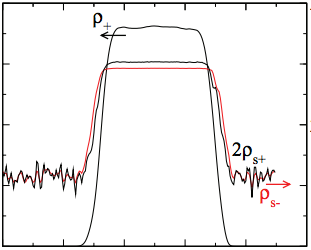Abstract
Complex coacervation, a liquid-liquid phase separation that occurs when two oppositely charged polyelectrolytes are mixed in a solution, has the potential to be exploited for many emerging applications including wet adhesives and drug delivery vehicles. The ultra-low interfacial tension of coacervate systems against water is critical for such applications, and it would be advantageous if molecular models could be used to characterize how various systemproperties (e.g., salt concentration) affect the interfacial tension. In this article we use field-theoretic simulations to characterize the interfacial tension between a complex coacervate and its supernatant. After demonstrating that our model is free of ultraviolet divergences (calculated properties converge as the collocation grid is refined), we develop two methods for calculating the interfacial tension from field-theoretic simulations. One method relies on the mechanical interpretation of the interfacial tension as the interfacial pressure, and the second method estimates the change in free energy as the area between the two phases is changed. These are the first calculations of the interfacial tension from full field-theoretic simulation of which we are aware, and both the magnitude and scaling behaviors of our calculated interfacial tension agree with recent experiments.
